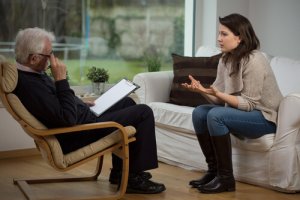What is Rapport? Techniques for Relationship Building

The word rapport comes from the French word rapporter, which means “to bring back.” It alludes to one person sending a message and the other person returning it. Rapport is the bond between two or more people. It’s also the psychological and emotional harmony needed for changes in either person.
Rapport is an important factor in therapeutic relationships, but it’s often overlooked. Researchers believe much of the success achieved by psychological treatment is due to a good therapeutic relationship. Or in other words, good rapport between the therapist and the patient.
The relationship with the patient
Things like therapeutic approach, previous psychological evaluation, and techniques used during treatment are highly important when treating a patient. So is establishing a good relationship with the patient. They must fully trust you and take the treatment seriously.
None of the rest matters if you don’t have a good relationship with your patient, because it can affect all the other variables. They might not come to sessions, be committed to the treatment, be motivated to change, or trust what you say or suggest.
When we talk about therapeutic rapport, we mean people having a mutual understanding, a collaborative attitude, and enough empathy to tackle a common problem and achieve the desired goals. It’s so important these days that future therapists are taught in about this. There are even specialized courses on this subject geared towards different professionals, especially in the field of healthcare.
The origins of rapport
The idea of a therapeutic alliance, or rapport, was developed throughout the 20th century. In his 1912 paper The Dynamics of Transference, psychoanalyst Sigmund Freud considered the need for the analyst to have an interest in and an understanding attitude towards the patient. The objective was that the healthy part of the patient would establish a positive relationship with the analyst.
Freud defined the patient’s affection towards the therapist as a beneficial and positive form of transference. In psychoanalysis, transference is a psychological process through which the client transfers their unconscious thoughts and emotions onto the other person, the therapist.

Freud thought that positive transference promoted trust, acceptance, and credibility in the patient’s interpretation of the therapist. However, it was later discovered that it wasn’t transference that created this environment of trust and collaboration between the therapist and the patient. Sometimes it would lead to misunderstandings, which are obviously not positive.
It was James Zetzel who distinguished between transference and the therapeutic alliance. He suggested that the alliance was the non-neurotic part of the relationship, which allowed for insight and the adoption of therapeutic changes.
Later, rapport was incorporated into the majority of therapeutic approaches, distancing themselves from the idea of transference suggested by psychoanalysis.
The quality of the relationship
According to Carl Rogers, father of humanistic psychology, it’s essential to pay attention to the quality of the therapist-patient relationship. Rogers proposed three fundamental characteristics that the therapist must possess: congruence (or authenticity), unconditional positive regard (or acceptance), and empathic understanding.
According to Rogers, the likelihood of therapeutic progress depended less on the therapist’s personality and attitude and more on the way the patient experiences these things. For their interpretation to be positive, they must feel understood and unconditionally accepted.
In the 1970s, Edward Bordin described common characteristics that must be present in the therapeutic relationship. He identified three components of rapport that the patient and therapist must agree on: tasks, goals, and bond.
Techniques to create a good rapport
The two fundamental pillars that rapport is based on are trust and fluid communication. The therapist and client should understand each other’s verbal and non-verbal communication. Communication should be asymmetrical, because the patient should disclose more than the therapist.
Here are some effective techniques in establishing a good rapport:
Active listening
This might seem like a simple technique, but it’s often pretty difficult to actually achieve. It involves listening to the patient without interrupting or making value judgments. It’s also about showing them through gestures and expressions that you’re by their side, listening attentively, understanding what they mean, and empathizing with their emotions.

Warmth
For there to be good rapport, it’s important to show warmth towards the client. Even if you know a lot of useful techniques and have a lot of experience.
Without warmth, the patient won’t trust you or be open with you, and won’t disclose important information. The lack of trust will directly affect the patient’s level of commitment to the treatment. This makes it less likely for them to practice the techniques you suggest.
If someone is suffering from an emotional problem, coldness won’t help at all. To promote the empathy and acceptance that Rogers talked about, there must be warmth.
Empathy
It’s obvious that you have to be able to put yourself in the other person’s shoes if you want to help them. It doesn’t matter if the patient suffers from an affective disorder or if they’ve committed a crime. If you’re going to treat them, you have to see the world through their eyes. You must do this even if you don’t share their feelings or agree with their actions. The only way to build trust and help the person is to be empathetic.
Trust
It’s important for the patient to feel at ease when they go to therapy sessions. To build trust, in addition to everything else you have to be and appear credible.
The patient must believe that you are a professional, that you’ve been well-trained, and that you would do whatever it takes to get them the help they need. This could be either referring them to another therapist or training yourself to treat whatever they’re suffering from. That way, they’ll trust you.

Common goals
When developing rapport, try to focus on things you have in common that will help you move towards the client’s therapeutic goal. It’s important to not get off track and end up talking about common interests that have nothing to do with the goal. If you do, you’ll waste time, and the relationship will stop being asymmetrical.
However, it doesn’t hurt to be flexible and create a relaxed environment where you can touch on things outside of the therapeutic goal. As long as you’re careful not to stray too far off topic.
Consistency between verbal and non-verbal language
Be careful when it comes to communicating with your patient, since people often say things that contradict their expressions or gestures. Consistency between verbal and non-verbal language is fundamental to the therapeutic relationship. Without it you cannot create an environment of trust and collaboration.
When your posture or facial expression contradicts what you’re saying, the non-verbal message will prevail because it is more unconscious, and therefore more authentic.
Therefore, like Rogers said, you must come off as authentic and genuine with your patient. Watch your posture and maintain warmth, acceptance, and empathy in both your verbal and non-verbal communication.

What to do when you can’t establish good rapport
While these techniques might seem like common sense, they’re not so easy to put into practice when you’re actually with a patient in your office. Therapists are also human beings, with their own values, attitudes, and emotions. Leave these at the door for the client to make progress.
Even if you still can’t establish a good relationship with the client, don’t feel disappointed. Just like you don’t always have good chemistry with people in your personal life, the same thing can happen in therapeutic relationships. This can happen even when you put in all your effort to make sure that doesn’t happen.
In this case, the most honest thing to do would be to refer the client to another therapist who will be able to develop a better therapeutic alliance with them and resume their process of personal growth. That way, neither of you will be wasting your time and you’ll still be moving towards your common goal – the patient’s improvement.
References
Rogers, C. (1951). Client-centered therapy: Its current practice, implications and theory. London: Constable.
Corbellá, S., Botella, L. (2003). La alianza terapéutica: historia, investigación y evaluación. Servicio de publicaciones de la Universidad de Murcia. ISSN: 0212-9728
Freud, A. (1936). The ego and the defense mechanisms. Wien:Int. Psychoanal. Verlag.
The word rapport comes from the French word rapporter, which means “to bring back.” It alludes to one person sending a message and the other person returning it. Rapport is the bond between two or more people. It’s also the psychological and emotional harmony needed for changes in either person.
Rapport is an important factor in therapeutic relationships, but it’s often overlooked. Researchers believe much of the success achieved by psychological treatment is due to a good therapeutic relationship. Or in other words, good rapport between the therapist and the patient.
The relationship with the patient
Things like therapeutic approach, previous psychological evaluation, and techniques used during treatment are highly important when treating a patient. So is establishing a good relationship with the patient. They must fully trust you and take the treatment seriously.
None of the rest matters if you don’t have a good relationship with your patient, because it can affect all the other variables. They might not come to sessions, be committed to the treatment, be motivated to change, or trust what you say or suggest.
When we talk about therapeutic rapport, we mean people having a mutual understanding, a collaborative attitude, and enough empathy to tackle a common problem and achieve the desired goals. It’s so important these days that future therapists are taught in about this. There are even specialized courses on this subject geared towards different professionals, especially in the field of healthcare.
The origins of rapport
The idea of a therapeutic alliance, or rapport, was developed throughout the 20th century. In his 1912 paper The Dynamics of Transference, psychoanalyst Sigmund Freud considered the need for the analyst to have an interest in and an understanding attitude towards the patient. The objective was that the healthy part of the patient would establish a positive relationship with the analyst.
Freud defined the patient’s affection towards the therapist as a beneficial and positive form of transference. In psychoanalysis, transference is a psychological process through which the client transfers their unconscious thoughts and emotions onto the other person, the therapist.

Freud thought that positive transference promoted trust, acceptance, and credibility in the patient’s interpretation of the therapist. However, it was later discovered that it wasn’t transference that created this environment of trust and collaboration between the therapist and the patient. Sometimes it would lead to misunderstandings, which are obviously not positive.
It was James Zetzel who distinguished between transference and the therapeutic alliance. He suggested that the alliance was the non-neurotic part of the relationship, which allowed for insight and the adoption of therapeutic changes.
Later, rapport was incorporated into the majority of therapeutic approaches, distancing themselves from the idea of transference suggested by psychoanalysis.
The quality of the relationship
According to Carl Rogers, father of humanistic psychology, it’s essential to pay attention to the quality of the therapist-patient relationship. Rogers proposed three fundamental characteristics that the therapist must possess: congruence (or authenticity), unconditional positive regard (or acceptance), and empathic understanding.
According to Rogers, the likelihood of therapeutic progress depended less on the therapist’s personality and attitude and more on the way the patient experiences these things. For their interpretation to be positive, they must feel understood and unconditionally accepted.
In the 1970s, Edward Bordin described common characteristics that must be present in the therapeutic relationship. He identified three components of rapport that the patient and therapist must agree on: tasks, goals, and bond.
Techniques to create a good rapport
The two fundamental pillars that rapport is based on are trust and fluid communication. The therapist and client should understand each other’s verbal and non-verbal communication. Communication should be asymmetrical, because the patient should disclose more than the therapist.
Here are some effective techniques in establishing a good rapport:
Active listening
This might seem like a simple technique, but it’s often pretty difficult to actually achieve. It involves listening to the patient without interrupting or making value judgments. It’s also about showing them through gestures and expressions that you’re by their side, listening attentively, understanding what they mean, and empathizing with their emotions.

Warmth
For there to be good rapport, it’s important to show warmth towards the client. Even if you know a lot of useful techniques and have a lot of experience.
Without warmth, the patient won’t trust you or be open with you, and won’t disclose important information. The lack of trust will directly affect the patient’s level of commitment to the treatment. This makes it less likely for them to practice the techniques you suggest.
If someone is suffering from an emotional problem, coldness won’t help at all. To promote the empathy and acceptance that Rogers talked about, there must be warmth.
Empathy
It’s obvious that you have to be able to put yourself in the other person’s shoes if you want to help them. It doesn’t matter if the patient suffers from an affective disorder or if they’ve committed a crime. If you’re going to treat them, you have to see the world through their eyes. You must do this even if you don’t share their feelings or agree with their actions. The only way to build trust and help the person is to be empathetic.
Trust
It’s important for the patient to feel at ease when they go to therapy sessions. To build trust, in addition to everything else you have to be and appear credible.
The patient must believe that you are a professional, that you’ve been well-trained, and that you would do whatever it takes to get them the help they need. This could be either referring them to another therapist or training yourself to treat whatever they’re suffering from. That way, they’ll trust you.

Common goals
When developing rapport, try to focus on things you have in common that will help you move towards the client’s therapeutic goal. It’s important to not get off track and end up talking about common interests that have nothing to do with the goal. If you do, you’ll waste time, and the relationship will stop being asymmetrical.
However, it doesn’t hurt to be flexible and create a relaxed environment where you can touch on things outside of the therapeutic goal. As long as you’re careful not to stray too far off topic.
Consistency between verbal and non-verbal language
Be careful when it comes to communicating with your patient, since people often say things that contradict their expressions or gestures. Consistency between verbal and non-verbal language is fundamental to the therapeutic relationship. Without it you cannot create an environment of trust and collaboration.
When your posture or facial expression contradicts what you’re saying, the non-verbal message will prevail because it is more unconscious, and therefore more authentic.
Therefore, like Rogers said, you must come off as authentic and genuine with your patient. Watch your posture and maintain warmth, acceptance, and empathy in both your verbal and non-verbal communication.

What to do when you can’t establish good rapport
While these techniques might seem like common sense, they’re not so easy to put into practice when you’re actually with a patient in your office. Therapists are also human beings, with their own values, attitudes, and emotions. Leave these at the door for the client to make progress.
Even if you still can’t establish a good relationship with the client, don’t feel disappointed. Just like you don’t always have good chemistry with people in your personal life, the same thing can happen in therapeutic relationships. This can happen even when you put in all your effort to make sure that doesn’t happen.
In this case, the most honest thing to do would be to refer the client to another therapist who will be able to develop a better therapeutic alliance with them and resume their process of personal growth. That way, neither of you will be wasting your time and you’ll still be moving towards your common goal – the patient’s improvement.
References
Rogers, C. (1951). Client-centered therapy: Its current practice, implications and theory. London: Constable.
Corbellá, S., Botella, L. (2003). La alianza terapéutica: historia, investigación y evaluación. Servicio de publicaciones de la Universidad de Murcia. ISSN: 0212-9728
Freud, A. (1936). The ego and the defense mechanisms. Wien:Int. Psychoanal. Verlag.
This text is provided for informational purposes only and does not replace consultation with a professional. If in doubt, consult your specialist.







